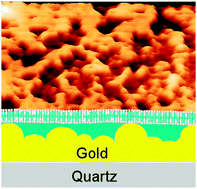Viscoelastic changes measured in partially suspended single bilayer membranes†
Abstract
For studies involving biomimetic phospholipid membrane systems, such as membrane-protein interactions, it is crucial that the supported membrane is biomimetic in its physical properties as well as in its composition. Two often overlooked aspects of biomimicry are the need for unrestrained lipid mobility, reflected in the viscoelastic properties of the membrane, and sufficient space between the membrane and the support for the insertion of transmembrane proteins. Here we show for a series of DMPC-based membranes that a partially suspended single bilayer membrane can be formed on functionalized gold surface without tethering. These membranes exhibit sufficient freedom of motion to represent the viscoelastic properties of a free lamellar bilayer membrane as demonstrated by determining the phase transition temperatures of these single bilayer membranes from the viscosity change upon chain melting using the dissipation signal of a quartz crystal microbalance (QCM-D). Atomic force microscopy imaging confirmed confluent, smooth membrane coverage of the QCM-D sensor that completely obscured the roughness of the sputtered gold surface. High-force AFM imaging was able to push membrane patches into the valleys of the gold morphology, confirming the inherently suspended nature of the MPA supported membrane. We show that the correlation between frequency and dissipation changes in the QCM-D sensograms is a sensitive indicator of the morphology of the membrane.


 Please wait while we load your content...
Please wait while we load your content...